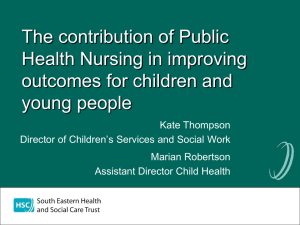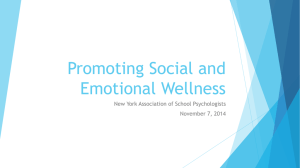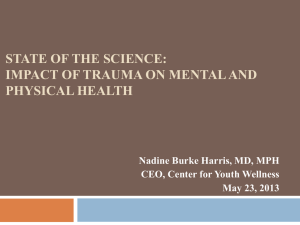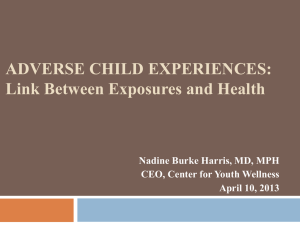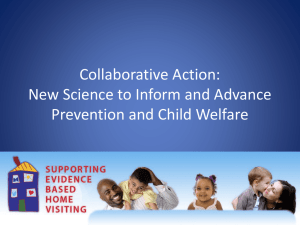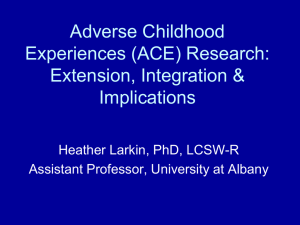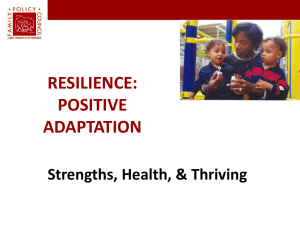The Children`s Resilience Initiative: One Community`s
advertisement
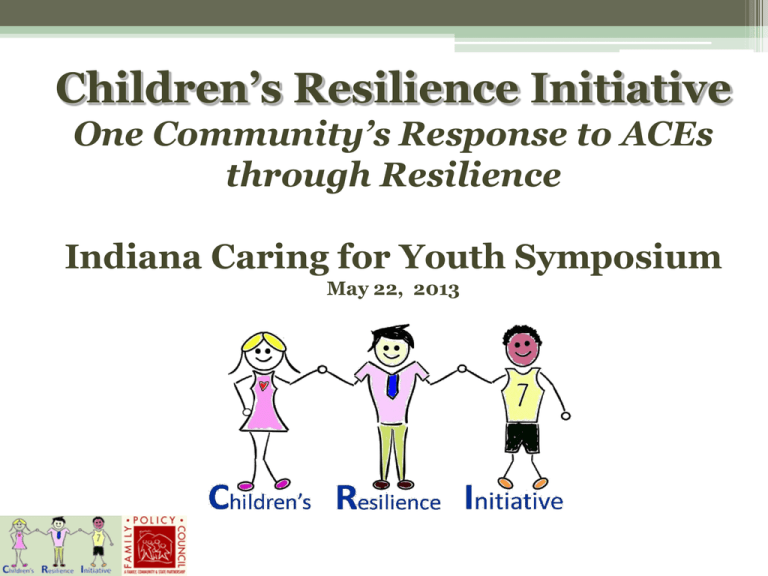
Children’s Resilience Initiative One Community’s Response to ACEs through Resilience Indiana Caring for Youth Symposium May 22, 2013 Our Goal Today To explore the impact of Resilience– the powerful force that can drive action forward for our community– within the context of ACEs, brain development, and health outcomes. Children’s Resilience Initiative Key learning: • How daily childhood experiences affect how the brain develops • How that shapes who we become as adults and what kind of life we have • That early negative experience is not fate, that an ACE score is not a life sentence • That we can help our children develop the resilience to rise above life’s challenges • There is a very real promise of hope and healing A community response to Adverse Childhood Experiences • Broad-based Children’s Resilience Initiative (CRI) Team • Raise awareness of ACEs • Foster resilience • Embed principles in the practice of organizations and programs Making all of our systems traumainformed is a social movement. It addresses a big missing piece of human rights. Children are safer when they have value. A community’s norms and values about how adults respect children provide stronger safety nets than law enforcement can do alone. Adverse Childhood Experiences (ACE) Study Centers for Disease Control and Kaiser Permanente HMO in San Diego, CA. 17,300 Adults Tracked health outcomes based on childhood ACEs 75% Caucasian, 39% college graduates, 36% some college, living wage jobs with insurance; median age 57 yr. old Adverse Childhood Experiences (ACE) Study Centers for Disease Control and Kaiser Permanente HMO in San Diego, CA. 17,300 Adults Tracked health outcomes based on childhood ACEs 75% Caucasian, 39% college graduates, 36% some college, living wage jobs with insurance; median age 57 yr. old ADVERSE CHILDHOOD EXPERIENCE Children’s Resilience Initiative INTEGRATING BRAIN & EPIDEMIOLOGICAL RESEARCH What are the Adverse Childhood Experiences? 1. Child physical abuse 2. Child sexual abuse 3. 4. 5. 6. Child emotional abuse Physical Neglect Emotional Neglect Mentally ill, depressed or suicidal person in the home 7. Drug addicted or alcoholic family member 8. Witnessing domestic violence against the mother 9. Loss of a parent to death or abandonment, including abandonment by divorce 10. Incarceration of any family member Adverse Childhood Experiences (ACEs) THE # 1 CHRONIC HEALTH EPIDEMIC in the United States “The impact of ACEs can now only be ignored as a matter of conscious choice. With this information comes the responsibility to use it.” Anda and Brown, CDC Response gets bigger Dose-Response Relationship: More ACEs = More Disease Dose gets bigger Higher ACE Score Increases Smoking 6 of 100 people with 0 ACEs smoke 11 of 100 people with 3 ACEs smoke 17 of 100 people with 7 ACEs smoke ACE Score Increases Suicide Attempt 1 of 100 people with 0 ACEs attempt suicide 10 of 100 people with 3 ACEs attempt suicide 20 of 100 people with 7 ACEs attempt suicide Life-long Physical, Mental & Behavioral Health Outcomes Linked to ACEs • • • • • • • • • • • • • • • • Alcohol, tobacco & other drug addiction Auto-immune disease Chronic obstructive pulmonary disease & ischemic heart disease Depression, anxiety & other mental illness Diabetes Multiple divorces Fetal death High risk sexual activity, STDs & unintended pregnancy Intimate partner violence—perpetration & victimization Liver disease Lung cancer Obesity Self-regulation & anger management problems Skeletal fractures Suicide attempts Work problems—including absenteeism, productivity & on-the-job injury A Significant Portion of Outcomes is Attributable To ACES 54% of depression 58% of suicide attempts 39% of ever smoking 26% of current smoking 65% of alcoholism 50% of drug abuse 78% of IV drug use 48% of promiscuity (≥ 50 sexual partners) (based on females in original study) Population Attributable Risk- WA State Data Percentage of ACE impact to sectors of life and society • 62%: at least 1 ACE • 25%: 3 or more ACE • 5%: more than 6 • Cluster/co-occur 87% with 1 ACE have another • 1 in 3 Emotional Abuse • 1 in 4 Sexual Abuse • > 1 in 5 Substance Abuse • > 1 in 5 Loss of Parent • 1 in 7 Mental Illness • 1 in 7 Physical Abuse • 1 in 8 DV ACEs & Disability Child Abuse High ACE Score High ACE Score Permanent Disability Permanent Injury Substance Abuse On-the-Job Injury Anxiety, Depression, Other Mental Health Disorder Temporary Disability from Work Intermittent Disability The truth about childhood is stored up in our bodies and lives in our souls. Our intellect can be tricked, our feelings can be numbed and manipulated, our perception shamed and confused, our bodies tricked with medication, but our soul never forgets. And because we are one, one whole soul, in one body, someday our body will present its bill. ~ Alice Miller Closing thoughts on ACE Study • The science behind this is fact • “Witness” phenomenon • 35% reduction in office visits • 11% reduction in ER visits • 80% of diagnostics is family history • AMA and Three National Academies • Hope, healing and a future BRAIN RESEARCH: THE NEUROBIOLOGY OF MALTREATMENT See for example: “Neurobiological and Behavioral Consequences of Exposure to Childhood Traumatic Stress,” Stress in Health and Disease, BB Arnetz and R Ekman (eds). 2006. Martin Teicher, Jacqueline Samson, Akemi Tomoda, Majed Ashy, and Susan Anderson Teicher, M. “Scars that Won’t Heal: The Neurobiology of Child Abuse,” Scientific American, March, 2002, pp. 68-75. EXPERIENCE DRIVES DEVELOPMENT The brain works using chemicals and electricity Genetic Predispositions Experience Experience Shapes Brain’s Developmental Sequence • Size, shape & efficiency of brain regions can be reduced • Chemistry- those created early are most easily produced for life • Electrical grid- wiring, efficiency impacted Example Developmental Outcomes Middle Childhood • Connection between hemispheres • Multi-modal problem solving • Understanding social cues Adolescence Early Childhood • Self-regulation • Production of hormone paths • Verbal memory • Regulation/ dysregulation of mental health • Executive function • Sound judgment • Understanding of consequences Brains to Fit the Life We’ll Live Toxic Stress Assuming a neutral start: All brains will adapt to survive DEVELOPMENT INDIVIDUAL for a tough life: • Emotion processing regions smaller, less efficient • Efficient production of stress-related chemicals • Dysregulated happy hormones • Fewer receptors for calming • Less white matter characteristics & traits • Competitive • Hot tempered • Impulsive • Hyper vigilant • “Brawn over brains” or • Withdrawn • Emotionally detached • Numb DEVELOPMENT for a good life: • Emotion processing regions robust and efficient • Abundant happy hormones • High density white matter, especially in mid-brain INDIVIDUAL characteristics & traits • Laid back • Relationshiporiented • Reflective • “Process over power” WHY IT WORKS Under the worst conditions, such as war & famine, both the individual & the species survive. WHY IT WORKS By striving for cooperative relationships, individual & species live peacefully. Key Variables In Brain Outcomes Critical Time: Age of Maltreatment The brain develops over time. The effects of maltreatment correspond to the region and/or function that is developing at the time of maltreatment. Types of Abuse Gender Different types of maltreatment activate different processes that shape the brain, such as chemicals & hormones, electrical activity, cell growth, & specialization of cells. Although both boys & girls are affected by maltreatment the effects of sexual abuse are more profound in girls while the effects of neglect are more profound in boys. CORPUS CALLOSUM HIPPOCAMPUS The center for: •Controlling emotional reactions •Constructing verbal memory •Constructing spatial memory VULNERABLE TO: All forms of maltreatment in the first 2-3 years of life. Integrates hemispheres & facilitates: • Language development • Proficiency in math • Processing of social cues, such as facial expression RIGHT TEMPORAL GYRUS Center for spoken language. VULNERABLE TO: Emotional abuse, especially between ages 7 and 9. VULNERABLE TO: Neglect in infancy. Sexual abuse in the elementary school years. 27 ACE Study: A Paradigm Shift • Behavioral responses resemble common delinquent behaviors and are under-identified as trauma symptoms • Stress manifestation is different by ages, stages, expression • Many just don’t connect the symptoms to trauma …Thus leading to punishment rather than help Why do some rise above the ACE load and others don’t? • Attachment to caring adult(s) via mentors • Opportunities • Choices • Relationships • Timing This is NOT about letting people off the hook, or excusing actions because of trauma history Data suggest accountability CAN actually increase! Children’s Resilience Initiative Opportunities for Resilience Moving forward with this powerful information For the most part, resilience is about the dayto-day ways we interact with and help each other. Current research is discovering that nurturance is actually reparative and regenerative!! Resilience Occurs At All Levels A universal capacity which allows a person, group, or community to prevent, minimize, or overcome the damaging effects of adversity. Dr. Edith Grotberg Individual Family Community National, Global, Ecosystem A “Trauma Lens” can help to better understand a patient’s behavior. A shift in perspective from: “What is wrong with this person?” to “What has this person been through?” 36 Survival Mode Response Can’t effectively: Stressed Brains • Respond • Learn • Process Allow time to calm & return to higher brain functioning MODELS OF RESILIENCE Grotberg I HAVE (external supports) I AM (personal strengths) Boss Attachment & belonging Blaustein Masten Brooks & Goldstein Attachment Community, Regulation culture & spirituality I CAN (social & interpersonal skills) Capability Competence Connection Positive relationship w/caring adult Affirmation Self-esteem through emotional awareness & control Chores, choices, mastery of skills Effectiveness in one’s own world I HAVE (external supports) • People around me I trust and who love me, no matter what • People who set limits for me so I know when to stop before there is danger or trouble • People who show me how to do things right by the way they do things • People who want me to learn to do things on my own • People who help me when I am sick, in danger, or need to learn = safety & security: core for developing resilience I AM (internal, personal strengths) • A person people can like and love • Glad to do nice things for others and show my concern • Respectful of myself and others • Willing to be responsible for what I do • Sure things will be all right = inner strength or hope; feelings, attitudes and beliefs within the child I CAN (social/interpersonal skills) • Talk to others about things that frighten me or bother me • Find ways to solve problem that I face • Control myself when I feel like doing something not right or dangerous • Figure out when it is a good time to talk to someone or to take action • Find someone to help me when I need it = mastery, sense of future Resilience Treasure Hunt Night at Elementary School A Positive Relationship with One Adult Children who experienced trauma and grew up to be successful consistently identified one variable: connecting to an adult who they felt cared about them and believed in them. ▫ We can each be that caring person Looking through the “trauma lens”… “Not realizing that children exposed to inescapable, overwhelming stress may act out their pain, that they may misbehave, not listen to us, or seek our attention in all the wrong ways, can lead us to punish these children for their misbehavior… If only we knew what happened last night, or this morning before she got to school, we would be shielding the same child we’re now reprimanding.” On Playing A Poor Hand Well by Mark Katz Children’s Initiative Children’s ResilienceResilience Initiative SKILL BUILDING Think Not Lack of Skill Intentional Misbehavior Building Missing Skills Shaming for Lack of Skills Nurture Criticize Teach Blame Discipline Punishment Responses • • • • • Liberating- leave behind the shame and blame I thought it was my fault Now I know why I’m on my 4th marriage This saved my life I understand better now why my mother parented the way she did, but I will break the cycle • I will be intentional in building resilience • Hope and healing; I’m not alone • Why haven’t I heard about this before? Our Community’s Response • • • • • • • • • • • • • Website & facebook; resources, videos, news Resilience tools for Parents “New Parent” & “moving upstream” tools Lincoln Alternative High School The Health Center at Lincoln Children’s Home Society Commitment to Community Christian Aide Center One Officer’s Story One Woman’s Story WWPD, Sheriff Dept, Penitentiary trainings Walla Walla Public Library partnership Dept of Court Services, Judge, Attorney 49 50 Resilience Deck of Cards includes 42 resilience building blocks and 10 ACE cards, 2 sets of Jokers and a Parent Handbook Community Action Toolbox Welcome to our Toolbox! •Getting Started: A Fish Tale of Sorts •Plow the Field •Once is Not Enough •Mid-Course Adjustments •New Targets •Taking It On the Road •Vital Learnings •Building the Framework • Nuts & Bolts •Integration & Sustainability •The “End” Game A community of practice- one in which representatives from each effort connect regularly to share what they are learning (John Kania) Children’s Resilience Initiative The public health impact of ACEs can now only be ignored as a matter of conscious choice. With this information comes the responsibility to use it. R. Anda, MD & D. Brown, DSc/W. Foege What we cannot argue anymore is that there’s nothing we can do. We can change our approach. Paul Tough, How Children Succeed Policy Implications • • • • School policy on discipline, suspensions, etc. Prevention as a priority and the will to act Earlier intervention with home visits Court system - mandatory class for divorcing parents • Awareness of potential for re-traumatization • Medical field - universal screening/growing recognition • Systems responses - Empathic vs. punitive response Children’s Resilience Initiative Empowering community understanding of the forces that shape us and our children Website: www.resiliencetrumpsaces.org
